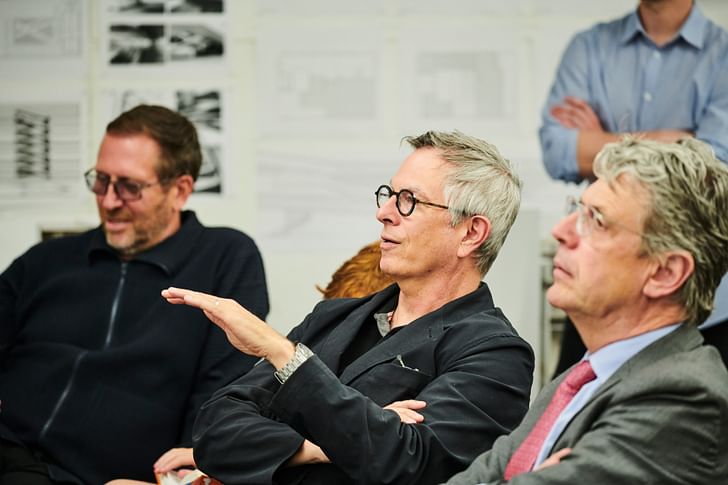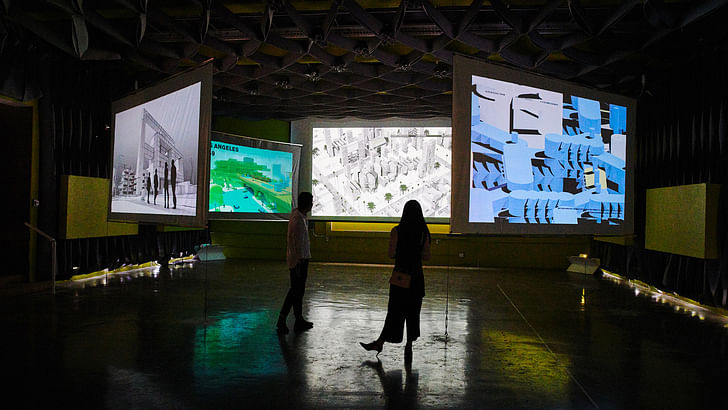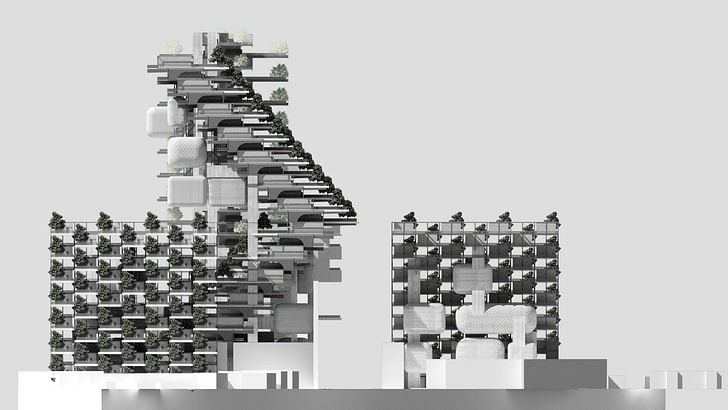

In 2019, Neil M. Denari was awarded the 2019 Educator of the Year award by the American Institute of Architects Los Angeles chapter, an award that caps a three-decade long career situated at the intersection of practice and teaching.
In light of the award, Archinect caught up with Denari to discuss his career in academia and his perspectives on education.
Neil M. Denari is an architect and educator with 20 years of experience bridging the gap between practice and teaching.
Denari’s architectural office, Neil M. Denari Architects (NMDA), has steadily completed a growing number of ambitious works that meld thoroughly digital approaches to form and materiality with a graphic urban presence, often delivering projects that act as evocative backdrops for city life in various capacities.

Perhaps the most well-known of these projects is HL23, a 14-story building that overlooks the High Line in New York City. The “supple” tower is softly contorted to the extents of the site’s zoning envelope, but lands on a 40-foot by 90-foot base, diminishing in size in order to accommodate the elevated park. The elevation facing the park is wrapped in wavy stainless steel panels, while opposing faces of the building feature blue-tinted glass and expressed structural trusses. An exercise in “how to stand out and fit in at the same time,” the condominium tower is one highlight in decades of practice by a firm, founded in 1988, that has completed or is currently working on projects in Los Angeles, Texas, Japan, New York City, and Vancouver, among other locales.

Over the years, the practice has published two monographs, including the gargantuan MASS X from 2018, while also garnering many accolades. In 2011, for example, Denari was awarded the American Institute of Architects Los Angeles (AIA|LA) chapter’s Gold Medal, an honor that “recognizes architects and individuals for their passion, talent, and undeniable contribution to Los Angeles.”
“[With teaching,] you have a certain freedom to engage with ideas, because success is not the measuring stick, ideas are the measuring stick.
While Denari’s collection of built work has taken shape, however, his prowess as an educator has grown in tandem. Denari, who received his BArch from the University of Houston in 1980 and an M.Arch from Harvard in 1982, has taught across the country at many schools of architecture, including the Southern California Institute of Architecture (SCI-Arc), where he served as Director from 1997 to 2002, Columbia University, Rice University, Princeton University, and, since 2002, at the University of California, Los Angeles Department of Architecture and Urban Design. In 2019, this academic work hit a crescendo of its own when Denari was awarded the Educator of the Year award by the AIA|LA, an annual recognition that celebrates exemplary teaching at local schools of architecture.

Describing the tension between teaching and practice, Denari tells Archinect, “There’s a sense that when you start your practice, as you get chances to engage with clients and it becomes a medium for you to carry out research ideas. But [in reality], you’re spending other people’s money, and you won’t get hired if you fail to deliver on those ideas.”
“Teaching, on the other hand,” Denari continues, “you have a certain freedom to engage with ideas, because success is not the measuring stick, ideas are the measuring stick. I particularly try to teach in a way that tries to break down the division between the no-constraints approach in school and the ‘real world’ where it’s nothing but constraints.”
Reflecting on the dueling yet complementary nature of his work as a practitioner and educator, Denari chalks the parallel successes to persistence and chance, explaining, “I don’t think anyone has a grand plan. I didn’t have a lot of work when I was younger, so teaching became an intellectual platform.”

A Fort Worth, Texas native, Denari moved to New York City after undergrad and worked for Columbia dean James Polshek for a period of time. Eventually, he moved out to Los Angeles, where he worked at “unknown offices” while teaching and nurturing a fledgling independent practice that was slow to start. Drawn to “the gravity of Los Angeles,” Denari explains, “I had a grand plan to come out here when I was a kid, I couldn’t have been more fascinated through the media projections of the city—the television, news, and movies. My impression was that Los Angeles had everything that I didn’t have in a place like Texas; It was the vision of an Arcadian utopia.”
But it wasn’t just the superficial beauty of Los Angeles that drew him to the city, as Denari explains, he also gravitated toward “the dark side of L.A.,” the elements that go beyond “Hollywood images,” and expose “the real conditions that exist here,” like the city’s constant flirtations with ecological disaster and other qualities that run directly counter to the idyllic qualities the city’s media image typically conveys. “Its a very mysterious place,” he continues, “Los Angeles is not fixed, it’s not figured out, it’s not morphological discrete, it's chaotic; And I think that’s why I’m here.”

“It’s a great unsolved urban mystery: You’ll never figure it out, but that doesn’t mean you’ll live in despair, it will become positive eventually.”
“Los Angeles is not fixed, it’s not figured out, it’s not morphological discrete, its chaotic; And I think that’s why I’m here.”
When UCLA AUD chair Hitoshi Abe stepped down from his post in 2016, Denari served as interim chair while the school underwent a selection process for Abe’s replacement, eventually settling on Heather Roberge. In the years since, Denari has refocused his educational approach to grapple with some of the pressing urban and environmental issues facing the city, particularly within the realm of urban density and the housing affordability crisis. Attempting to synergize between policy and design, one of Denari’s graduate research studios is currently undertaking speculative explorations at the urban scale that implement and super-charge a series of potential state-wide densification initiatives, including State Bill 50, a measure that would increase allowable densities for properties located within a certain proximity of rapid bus and rail transit.

The studios are looking to envision the urban impacts of such a measure by experimenting with mass timber building technologies and architectural approaches that “ratchet up scale and density” while also imbuing existing single-family neighborhoods in the city with a “speculative form of infill and [new] ground-up urbanisms.” “We’re asking the students to think about how new zoning meets geometric forms based around what you can do with wood buildings that branch over existing structures, occupy small footprints, deal in air rights and proximity, and create new forms of living based on challenging NIMBYism, based on optimism and a confrontation with limits.”
The research studios highlight Denari’s skill at merging two seemingly contradictory worlds, and much like NMDA’s built work, “illustrate the potentialities for bringing together geometry, materiality, and urbanism” while also considering issues of supply chains, embodied carbon, aesthetics, and other facets of design.
Denari credits UCLA’s institutional foundations as a public university with fueling the inquisitive nature of his academic practice, offering that “As a state-funded research institution that’s world renowned, the general arch of what it does is produce knowledge that can sometimes be incredibly speculative. It feels like that’s really the mission for the school.”
“We’re working,” Denari adds, “on behalf of the public.”
“It’s hard to say how that affects what I teach. Sometimes, it’s less material and more spiritual, and it’s very meaningful to be a part of a public school. UCLA is really special in that sense,” Denari adds, explaining that being located in a global city like Los Angeles means that the work the university undertakes “can directly help shift society and bring change.”
“Everyone who is at the school shares that mission,” he continues, “otherwise they’d defect somewhere else for more money. There’s a different cultural currency at work and everyone is there to share in public discourse, it’s less like an enclave or an ivory tower because it’s history has always been about trying to reach the public.”
“We’re working,” Denari adds, “on behalf of the public.”
Another benefit of teaching at the school, Denari explains, is that its curriculum “blends technical and conceptual better and more effectively than a lot of other North American schools, where you might tend toward one or the other poles. We’re an ideas-driven school, but we’re also very technical. [Over the years] It has perfectly encapsulated my spirit as a teacher: I’m a concrete person, not a person who can only work with poetry and clouds, but I love the way poetry and clouds can speak to the conceptual drive and materialization of our work.”
These dual-natured perspectives, between practice and teaching, building and thinking, inform the urgency of Denari’s educational approach. Right now, “we’re highly engaged in discourse and that’s where being an architect is a very interesting thing,” Denari adds finally, “in a way we don’t have very much power, but also, we are responsible for carrying on the public discourse. We don’t make policy, but are expected, especially as professors, to say something.”
Antonio is a Los Angeles-based writer, designer, and preservationist. He completed the M.Arch I and Master of Preservation Studies programs at Tulane University in 2014, and earned a Bachelor of Arts in Architecture from Washington University in St. Louis in 2010. Antonio has written extensively ...
5 Comments
"I particularly try to teach in a way that tries to break down the division between the no-constraints approach in school and the ‘real world’ where it’s nothing but constraints." It's interesting to think of a school with no constraints that prepares you to work as an architect where it's nothing but constraints.
It' a kind of black and white thinking that is encouraged by the polemics of academia, but doesn't reflect the more nuanced experience of life in either field. Constraints can be the source of wonderful ideas.
Neil is a real piece of work. I remember a particularly uncomfortable interaction with him while on a site visit to his Mar Vista house for UCLA's open house when I was still deciding between graduate schools. Neil is from Fort Worth, Texas (Burleson, if I remember correctly), and is a former colleague of several professors from my undergraduate, so I was already familiar with his work before going on the walk-through. In fact, I looked up to Neil at the time, that is, until the interaction I'm about ready to describe.
After Neil describes the brief provided to them by the clients, he mentioned that the family is very tech-savvy, loves Apple computers—the kitchen had some high-tech appliances and was even featured in a commercial for Phillips or some other appliance manufacturer. Cool, I guess. After his introduction, I walk up to him and ask very innocently if he's ever inspired by industrial design or even Apple products themselves whenever he is designing a project—mainly because he mentioned technology being a touch point in the brief from the clients, not to mention the passing similarity the project has to the first generation iMac (this is my personal opinion, which I did not state to Neil).
Neil glares at me and says, "Well obviously you know nothing of my work. This is my aesthetic that I've developed over the past 20 years in my studio..." and continues to chew me out about how ignorant I am about his genius. Obviously I struck a nerve with the guy, and as a young and eager student I couldn't believe that this was my first interaction with someone who, as I said, I already knew about and admired. Needless to say I chose SCI-Arc instead of UCLA, which also isn't immune to this over-inflated sense of self-importance. Didn't matter to me either way, I wasn't going to be in the same zip code as that douchebag. Don't meet your heroes, I suppose, and don't let arrogant pricks like Neil Denari hold positions that require grace and patience like a professor at a prestigious university like UCLA.
you're the one sounding arrogant
Not at all. That's like the Republicans closing their ears to the evidence against their dear leader. Neil says, "We're working on behalf of the public" yeah, sure you are.
Among other things, another demonstration of the disconnect between education and practice.
His ‘aesthetic’ is Parametricism lite, which probably explains the teaching gig. As does the bullshit: “We’re working,” Denari adds, “on behalf of the public.”
Block this user
Are you sure you want to block this user and hide all related comments throughout the site?
Archinect
This is your first comment on Archinect. Your comment will be visible once approved.